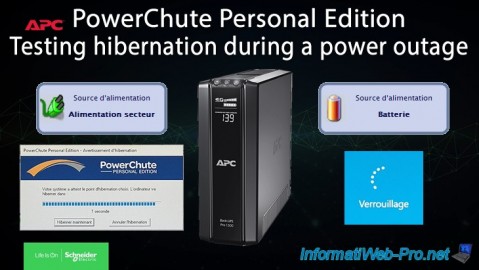- UPS
- APC Back-UPS Pro
- 01 September 2023 at 11:39 UTC
-

When you protect a server or computer with an UPS, it allows you to protect your hardware and keep your server or computer running even if a power outage occurs.
However, it's important to install and configure the PowerChute Personal Edition software on your computer or server so that it can shut down properly if the power outage lasts too long.
Thanks to PowerChute Personal Edition, you will be able to continue working during a small power outage and trigger a clean shutdown of your computer or server before your battery life becomes insufficient to shut down your computer or server.
- Autonomy without load
- Download and Install PowerChute Personal Edition
- Enable hibernation (hibernation)
- Actual UPS test (hibernation after long power outage)
1. Autonomy without load
Idle, when our computer is off, only 10 watts are consumed.

In our case, with this consumption of barely 10 watts, the estimated battery life is 253 minutes.

2. Download and Install PowerChute Personal Edition
To get started, download the PowerChute Personal Edition software from the APC site.

Then, install PowerChute Personal Edition like any other program.

3. Enable hibernation (hibernation)
When hibernation is not enabled or supported by your computer, a warning appears.
This warning appears in particular just after the installation of this software.

To enable hibernation from the PowerChute Personal Edition software, you will need to go to the section : Configuration -> Runtime.
Then, click on the link : Enable Hibernation.
Note : this blue link is only displayed when hibernation is disabled.

A "Hibernation Disabled" window appears.
Click : Allow.

However, this doesn't always work.
If so, search the Internet for how to enable hibernation for your version of Windows.
Additionally, we recommend that you test this hibernation manually from the Windows start menu once this option is enabled, as even enabled it may not work as expected due to Windows or your computer's misconfiguration. .
Warning : hibernation is not supported by all computers or servers.

Once hibernation is enabled, the "Allow Hibernation" link will disappear.

As you can see by clicking on the question mark, APC recommends that you enable hibernation on your computer or server to avoid losing data (changes made to open documents, for example).
However, this is not mandatory. Simply a recommendation.
When the condition configured in the "Configuration -> Uptime" section is met, PowerChute Personal Edition will put your computer into hibernation (if hibernation is enabled).
Otherwise, PowerChute Personal Edition will gracefully shut down your computer or server. Unsaved modifications to documents, images, ... will therefore potentially be lost (unless they are recovered via a system specific to the program used).
Note : when PowerChute Personal Edition wishes to hibernate or shut down your computer or server, a message will be displayed for a few seconds to allow you to cancel this automatic action if you wish.
This will allow you to save any open documents (for example), then hibernate or manually shut down your computer or server.

4. Actual UPS test (hibernation after long power outage)
In our case, we have enabled the hibernation of our computer, PowerChute Personal Edition will therefore put our computer into hibernation when the condition defined in the "Runtime" section is met.
In the "Configuration -> Runtime" section, you can choose :
- Preserve battery power : allows you to shut down your computer or server when it has been on battery power for at least a certain number of minutes.
This avoids stopping your computer or server unnecessarily when it comes to a fairly short power outage (30 seconds or 1 minute, for example).
On the other hand, if the power failure persists, the shutdown or hibernation of your computer or server will be launched so that it stops correctly.
This avoids errors, as well as the loss of data that would have been caused by the power cut. In addition, you save battery in case a new power cut occurs the same day after you have turned your computer or server back on. - Leave my computer running as long as possible : allows you to use your UPS batteries to their maximum, then initiate a shutdown or hibernation of your computer or server to allow it to shut down properly.
Be sure to choose a sufficient delay so that your computer has time to shut down properly before your UPS battery is completely drained.
For this tutorial, we chose the 2nd option and we chose the longer delay to avoid draining our UPS battery too much for this tutorial.

To see in real time the status of your UPS, go to the section : Monitor System -> Current Status.
Important : when the UPS is on AC Utility Power (which is its normal behavior), the time shown at the bottom of the PowerChute Personal Edition is the estimated runtime.

During a power outage, you will see that the power source (at the bottom of the window) has changed to "Battery" instead of "AC Utility Power".
You will also see that the battery is discharging and the input voltage is 0 volts.

Important : once the UPS is powered from its battery (which occurs during a power outage, for example), the time shown at the bottom of PowerChute Personal Edition is now the time to shutdown.
What is different from the autonomy of your UPS.
As you can see, at the moment PowerChute Personal Edition tells us that the shutdown time is 8 minutes.
In other words, in 8 minutes, PowerChute Personal Edition will initiate the shutdown or hibernation of our computer.

On the other hand, if we look on the screen of our UPS, we can see that there are 16 minutes of autonomy left.
So there is a difference of 8 minutes in our case. This difference is simply the timeout you chose in the "Configuration -> Runtime" section of PowerChute Personal Edition.

Once the desired delay is almost reached, you will see that the time to stop is less than 1 minute (< 1 min).
At this time, in our case, if we look at our UPS, we see that there are 8 minutes of autonomy left.
This corresponds to the delay chosen previously so that our computer has time to shut down properly before the battery of our UPS is completely empty.

Once the shutdown delay is over, a small "PowerChute Personal Edition - Hibernation Warning" window will appear and allow you to hibernate your computer now or cancel hibernation.
If you do nothing, your computer will go into hibernation in 10 seconds.
Plain Text
Your system has reached the chosen hibernation point. The computer will hibernate in: x seconds.

Wait while your Windows computer hibernates.

On your UPS, you will be able to see that your battery is almost empty (if you have chosen the 2nd option in the "Configuration -> Runtime" section).

Once power is restored, the power outlet icon will appear and the battery icon will disappear.
For the voltage, it will again be around 230V (theoretical value).

Wake your computer from hibernation by pressing, for example, a key on your keyboard or the power button on your computer (depending on what is possible in your case).

The Windows screen appears.

Return to your Windows session.

If hibernation (hibernation) is functional in your case, the applications that were open during the transition to hibernation will reappear.

If you go back to the "Monitor System -> Current Status" section of PowerChute Personal Edition, you will see that the power source is again "AC Utility Power" (at the bottom of the window).
You will also see that the battery is charging.
Note that this may take several hours. For the UPS model we have, a full charge takes 8 hours (information visible on your UPS data sheet on the APC website).

In the "Monitor System -> Performance" section, you will see that a new "Blackout" type power issue has been detected and the last battery operation is today.

Share this tutorial
To see also
-

UPS 8/18/2023
APC Back-UPS Pro 1500 - Unboxing and assembly
-

UPS 8/25/2023
APC PowerChute Personal Edition - Installation, overview and testing


You must be logged in to post a comment